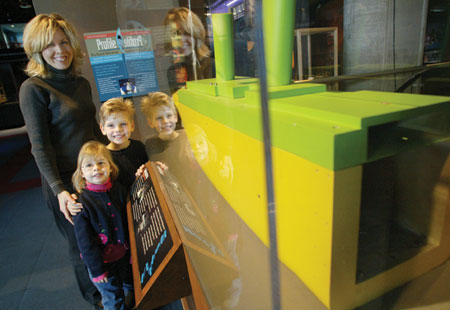
Laura Mikula, who
homeschools children Mia and Erik, gets great ideas for interactive
lessons when visiting Science Center exhibits like Titanic
Science. PHOTO: LISA KYLE
On a recent visit to the Titanic Science exhibit at Carnegie
Science Center, tour guide Erik Mikula explained the story
of the great ship’s ill-fated journey.
“Some of the crew and passengers spotted the iceberg
first. The captain tried to steer away from it, but it took
too long to steer because it was such a big ship. When the
ship hit the iceberg, they lowered the lifeboats and loaded
the women and children first.”
Mikula then moved over to a wall of photographs that chronicled
the stories and identities of passengers onboard that day.
“If a ship like that hit an iceberg today, things
would be different,” he explains. “There are
laws to make sure that every ship that crosses the ocean
has enough lifeboats to carry every passenger. And the two-way
radio is always on in case of emergency.”
Erik Mikula’s range of knowledge about the Titanic
is impressive. What’s even more impressive is that
he’s only six years old—and he learned everything
he knows about the Titanic at Carnegie Science Center.
Laura and David Mikula are the parents of Erik and his
four-year-old sister Mia. They’ve been members of
Carnegie Museums for two years, and because their children
are homeschooled, Laura uses the Science Center’s
exhibits and classes as valuable resources to enhance her
own lesson plans. “The Science Center allows us to
explore things in detail,” she says. “It opens
up whole new areas of learning and discussion.
“I never would have thought to introduce the Titanic
at kindergarten age, but Erik has learned about geography
and steel strength; all kinds of themes,” she adds.
“There are about 100 families in my homeschool group,
and many of us visit the Science Center and meet for discussion
on a regular basis. It does my job for me, in a sense. I
can bring the kids on a ‘field trip’ and it
gives me new ideas and makes my lessons more interactive.
I use the teacher’s manual to expand on what I’m
teaching.”
Erik has seen the Titanic exhibit five times. His interest
in boats of all kinds stems from his family’s own
sailboat excursions to Lake Arthur. The sheer size of the
Titanic is a real
fascination for Erik, and it’s brought down to scale
as a detailed model in the exhibit. Other components show
exactly how the ship went down and how it has rusted after
decades of resting on the ocean floor.
“The exhibits at the Science Center actually increase
our understanding of history and science,” said Laura.
“There’s a class on the submarine coming up
that Erik is really looking forward to.”
The story of the Titanic could be disturbing for young
children, but Laura feels that Erik’s main interest
is in the ship itself, and the tragedy of the Titanic hasn’t
“sunk in” just yet. Or, maybe it has.
When asked if he’d like to take a cruise on a big
ship like the Titanic someday, Erik ponders for a moment,
and then says thoughtfully, “Maybe.”
Back
| Top |